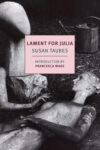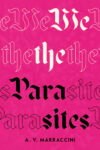
[Catapult; 2021]
In recent years, there have emerged a number of memoiristic essay collections that combine personal narrative and art criticism to evoke the writer’s intellectual development as well as to define their particular artistic sensibility. Works such as Jia Tolentino’s Trick Mirror and Cathy Park Hong’s Minor Feelings synthesize these elements to articulate not only acute diagnoses of culture — whether of the Internet in Tolentino’s case and Asian-Americanness in Hong’s — but portraits of the artists as young women. One of the predecessors of this form may be Susan Sontag’s sixties-defining essay collection Against Interpretation, which though light on explicit memoir, can be read as Sontag’s evolution of thinking through books, drama, and film, as well as an impassioned defense for sensuality, freedom, and continued innovation in the arts.
Larissa Pham, a Brooklyn-based visual artist, writer, and former Full Stop editor, writes in her intimate debut essay collection that she has always been attracted to this hybrid form, this cross between memoir and art criticism, which she defines as a variation on ekphrasis. Pham’s Pop Song is more concerned than Tolentino’s or Hong’s work with the telling of a linear narrative, which is her coming-of-age through love, trauma, and heartbreak from her college years at Yale to her late twenties. The heart of this coming-of-age story is a passionate but excruciating year-long love affair, in which Pham experiences both the ecstasies and despairs of first love. Pham entwines the more conventional coming-of-age narrative with an evolving commentary on intimacy, loss, and time through the media of visual art, pop music, and literature. The conjoined narratives convey not only the writer’s emotional and artistic maturation but also the development of what she calls her emotional language, which refers to the expression of ineffable feelings such as love and longing through pieces of art. Pham’s collection boldly reinterprets the memoir-essay genre by accompanying her stories of love with ekphratic commentary on the visual, aural, and verbal language of intimacy. This oblique, innovative method is the author’s makeshift solution to the problem she poses in the collection of how to write on intimacy. Through this form of ekphrasis, she is able to give texture to surface-level events and feelings, as well as to map out her own unique artistic sensibility.
The collection is organized in a loose chronological fashion from Pham’s undergraduate days as an art history student at Yale to her first encounter at a music festival with the man who will become her first love to travels in southern France, Taos, Mexico City, and finally to Shanghai, immediately after the devastating breakup with her boyfriend. Each essay corresponds to a particular point in time during her twenties and reflects on her orientation towards relationships, herself, and art at that specific age. The essays themselves are discursive, balletic meditations on subjects such as running in “On Running,” the wounded body in “Body of Work,” photography in “Camera Roll (Notes on Longing),” trauma in “Haunted,” pop music in “What We Say Without Saying,” and solitude in “On Being Alone.” At the same time, most of the essays consist of a chain of memories which are strung together to create a narrative arc. The recounting of these memories is often interrupted by musings on literature, visual art, and music in relation to intimacy and loss, as well as diaristic reflections on the memory in which she defines her relationship to the subject. As a result of this essayistic method, which parallels the works of W.G. Sebald and recent novels in fragments such as Jenny Offill’s Weather, the narrative arcs have a fragmentary, impressionistic feel, a sense that is further evoked by the deliberate arrangement of the text, which employs a line break between every paragraph and frequently resorts to the use of lists.
In this method, memories become like pieces of art to be lovingly evaluated — they are always contextualized, interpreted, and even questioned for their authenticity and truth. For example, in “Body of Work,” Pham recounts the memory of her breakup with her high school boyfriend. Pham realizes that this long-distance relationship has become toxic, mostly because her boyfriend has become controlling and disapproving over her lifestyle of drinking and going out. She recalls how she ends the relationship after he reproaches her for going out on a weekend, and a friend, exasperated with Pham’s boyfriend, writes in highlighter on her forearm to break up with her boyfriend. A few pages later, after exploring the painting Stare, a violent but beautiful portrait of an androgynous person’s bloodied face by Jenny Saville, Pham questions the authenticity of this memory: “But it seems that in my memory I wrote a different story than the truth of what happened, which is that when my boyfriend called that night, I lied to him and said that I was still at home.” Pham then uses the memory, the misremembrance of the memory, and Saville’s portrait to comment on how in the telling of the story, she wanted to create a more powerful, sadder ending in order to make visible her pain and woundedness, in the same way Saville renders her subject’s pain visible in her painting. Pham amalgamates these elements of personal narrative, confession, and ekphrasis to create a textured interrogation into her own relationship to woundedness, artifice, and representations of pain. This narrative method is really a form of accretion, of the accumulation of orchestrated images, of what Pham calls to “composite an image out of fragments,” each illuminated whether through memory or the interpretation of a piece of art and then frankly commented upon by the author, as a means of delineating a self, of portraying her evolving consciousness in relation to a subject. In the fashion of Roland Barthes’ Camera Lucida, the essays most resemble annotated photo albums, thematically and chronologically arranged assemblages of ekphratic expositions of photographic moments from the writer’s past and of encounters with pieces of art and literature that have moved her.
Pham’s exploration of her emotional language of photography, songs, and painting emerges from the telling of the fragmentary arc of her year-long love affair with a boyfriend referred throughout the collection only as “you,” and its immediate aftermath. Pham traces this arc from the consuming crush for the man after their first meeting, to the maturation of their relationship in New York and short intervals of time apart, the disintegration of the relationship in Mexico, and finally to Pham’s reckoning with the breakup in Shanghai. Pham portrays the story of the love affair as the fitful shifting of emotional distance between her boyfriend and herself. In the initial “crush” stage of the relationship, Pham guards her distance from her lover out of her fear of vulnerability. After she surrenders her defenses, the matured relationship is characterized by Pham’s desire to preserve their intimacy despite the physical and emotional distance that develops between them. Pham sees the evolution of this relationship represented in art when she encounters a series of drawings by Louise Bourgeois at an exhibit in Shanghai. Pham returns to the works, which depict “in two shades of red and pink, two sets of hands, coming together and apart across an expanse — a hand touching a wrist, then fingers interlaced, the pairs separating, reaching, clasping, holding.” These drawings, though they refer to the relationship between Bourgeois and her assistant, evoke for Pham a sense of the intimacy, separation, and longing of her year-long relationship. Pham’s thinking through Bourgeois’ art as a means of clarifying her relationship is a representative example of the way she interlaces the two narratives of the book — the development of her emotional language and her year-long love affair. It is also an example of the way she articulates the complex emotions of intimacy through that emotional language.
Pham repeatedly returns to the photograph as a fundamental unit of her emotional language, as a means for the expression of intimacy. In an undergraduate studio course in black-and-white film, Pham’s first forays into photography are pictures of various lovers, usually gazing downward or away, in different bedrooms at night. These pictures comprise what she considers a study of human closeness. The photographs become means to capture and preserve tenderness, longing, or closeness from past moments in time. She describes the intention of her artistic practice by thinking through the raw, intimate photographs of Peter Hujar. She writes that Hujar’s portraits achieve what she has always desired for her photography: “to capture that searching, close feeling, to manifest forever that tenderness I felt when taking a photograph.” This “close feeling” recalls Roland Barthes’ punctum, the particular, poignant detail of a photograph that holds the viewer’s gaze and stirs their emotions. This gaze that fixes the viewer recurs throughout the collection, both in Saville’s portraits and Hujar’s subjects, “who gaze so lucidly at the viewer in his photographs.” For Pham, the photograph becomes an example of what she calls “dark vessels.”
Pham derives the term from an essay by John Durham Peters on Hegel, in which he writes that “though language is a dark vessel and does not carry quite what I, as a speaking self, might think it does, it still manages to coordinate action between selves more often than not.” Like language, the photograph, song, or painting, represents a container for intimacy, a medium through which such fraught emotions can be articulated and possibly glimpsed by another. The use of photography as a dark vessel, as a language for intimacy, is metaphorically represented by a shared Instagram account with her year-long boyfriend. In the account, when they are physically distant from each other, both post only photographs, poetic moments from their quotidian lives and their artwork to express their feelings of longing for each other. Pham frequently laments the constraints of the spoken or written word as a means for the expression of intimacy, and photography becomes the means to hold those “close feelings” and to mediate their activation in the viewer even when the photographed moment has passed. For Pham, photography is a language itself, a vessel for communication, a way to “say without saying.”
However, just as Pham speaks to the risk of misremembrance and artifice in the narration of her memories, so she admits to an element of performativity in the composition of any photograph. In “Camera Roll (Notes on Longing),” she writes in detail on the technical processes of both taking and printing a photograph. This discussion is significant not only for demonstrating Pham’s loving fascination with photography, but also for suggesting that the photograph is always a product of orchestration on the part of the photographer. Pham describes how she deliberately adjusts the camera to present a desired version of the photographed moment: “I slid my finger on the screen to adjust the white balance, trying to capture the dimness of the light, trying to render you in a way as perfect and real as the way I was seeing you.” Pham argues that though the photograph seems to represent an objective image of reality, a sort of truth, it is actually always only an interpretation of reality. This is a result of how the camera is calibrated, what the photographer has chosen to include or exclude, how the photograph is staged, how it is developed, and with modern technology, how it is retouched and manipulated. For Pham, the artifice in photography lies in the fact that the presentation of reality is one that has been manipulated and contrived by the photographer and that the subject of the image may disagree with the story told by the image. Pham likens the construction of a photograph to the writing of a memory in that both suggest a narrative that might misrepresent reality or suggest a feeling true only to a fleeting moment in the past. Upon taking a photograph, she confesses she “knew at the time that there was already a lie that I was telling, or maybe a truth I could only hold on to for so long.” If photography is a language, then it can also be used as a form of deception — a way to perform a self or a relationship. Pham wonders whether in her photographs of her waking lovers she is “trying to trick intimacy out of these liminal moments.”
Pham’s concern with the infidelity of the photograph to reality recalls Plato’s famous critique of the danger of images, in which he condemns images for their false representation of reality and their dangerous ability to alter the minds of their viewers. However, Pham’s reflections on the artificiality of photography are less an indictment than a qualification of her love for the form. She still maintains that despite its artifice, even when manipulated by the photographer, the photograph is capable of expressing truth through its preservation of memory, through its practice of remembrance. Pham recalls altering an image of her grandmother after she passes away for the altar in a hundred-days memorial service. Pham manipulates the image with airbrushing, copying, and pasting so that her grandmother looks more like the family had known her, with a wide smile and bright eyes. She realizes that the manipulated photograph represents a truer version of her grandmother than the untouched original. Pham writes poignantly of the image, “It was her, more her than her.” This is reminiscent of Barthes’ thoughts on his dead mother’s photograph in Camera Lucida: “The photograph is literally an emanation of the referent.” The contrived photograph expresses the truth of her grandmother; it remembers the past better than the unaltered image. Therefore, the photograph preserves the truth despite its artificiality; or conversely, in the case of Pham’s grandmother and many of the photographs of Pham and her year-long boyfriend, artifice elicits the truth from the moment. She writes to her boyfriend of the naked intimacy of their relationship that is mediated by the photograph: “You wanted to see all of me, to know all of me, without performance or artifice . . . I think it shows in the photographs, the way my gaze shifts to meet yours — the way you slowly undid me.”
Pham’s absorption with the collection of vessels of intimacy, most explicitly represented by photographs of her and her boyfriend, is motivated by a fear of losing that intimacy, of loss of love. She repeatedly resorts to artifice and performance to construct a narrative of her relationship that preserves intimacy despite its infidelity to reality. If there is a coming-of-age for Pham in this textured, meditative book, then it lies in the shedding of artifice. In her visit to the exhibit of Louise Bourgeois’ work in Shanghai after her breakup, she realizes the art articulates her tumult, her aloneness, her sense of loss, but also the renewal of hope. The artwork, Hours of the Day, is composed of24 pages of drawing, each with a clock representing a different hour of the day, along with a few lines of the artist’s poetry. It becomes an example of Pham’s matured emotional language, mediating rather than shielding her confrontation with the naked self. Like Bourgeois, Pham undergoes a transformation into a state of hopeful clarity from despair. She opens herself to the impermanence of intimacy, the uncertainty of love. Like the narrator of Alex Dimitrov’s poem Impermanence, she learns that “looking at the night sky/is me looking at the past. At light/that’s long escaped and travels alone/but won’t always.”
Darren Huang is a Full Stop Reviews Editor and writer based in Manhattan.
This post may contain affiliate links.







